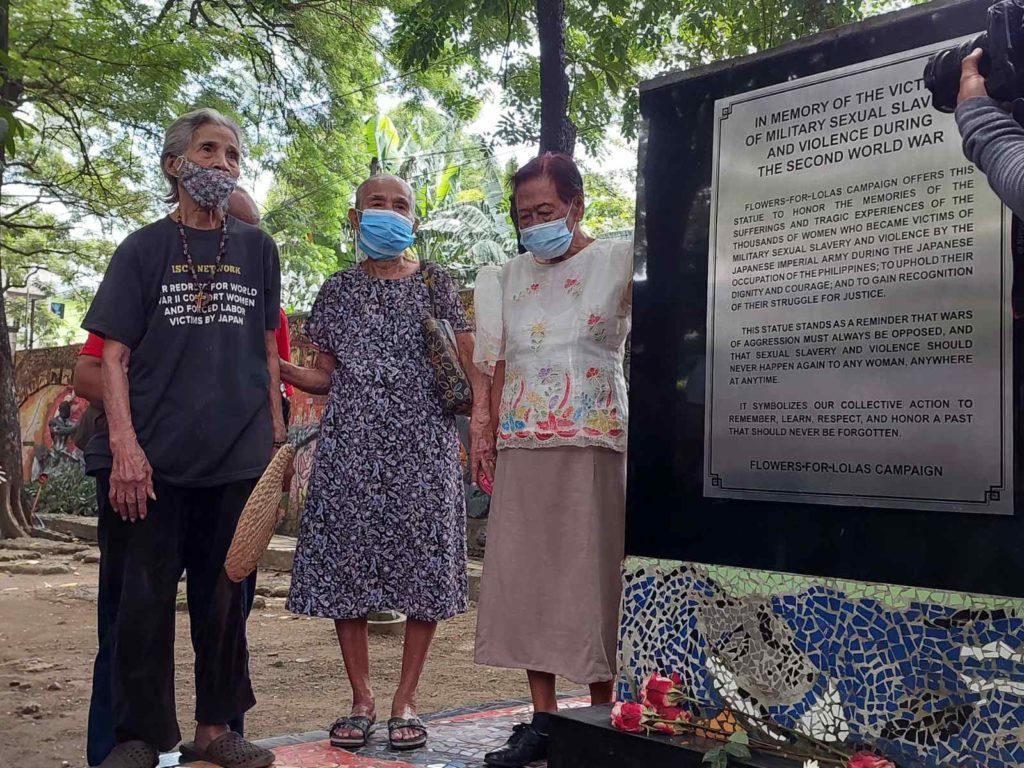
These are the three surviving Filipino comfort women who attended the 30th anniversary of their fight for justice. | Lawyer Dennis Gorecho
A Mass and flowers were offered last Saturday at the Redemptorist Church grounds in Baclaran, Parañaque to mark the 30th anniversary of Filipina comfort women’s fight for justice.
Thirty years ago, it was on Sept. 18, 1992 when Lola Rosa Henson first appeared after she heeded Nelia Sancho’s call over a radio station to encourage Filipina women who had been abused by wartime Japanese troops to come forward.
This became the catalyst for the comfort women movement in the Philippines.
Three of the surviving Filipina comfort women were present: Estelita Dy (92), Narcisa Claveria ( 91) and Fidencia David (96).
Lola Estelita was just 14 years old when she spent three weeks locked in a military brothel in Talisay, Negros Occidental during which she was repeatedly raped by Japanese soldiers.
”I tried to fight back when I felt pain. The Japanese got angry, held me by the head and pushed me to the table. When I regained consciousness, the Japanese was gone. A woman told me, next time, not to fight back because you might get killed. So every time I was being raped, I would just cry and cover my eyes,” Lola Estelita said in an interview.
Lola Narcisa was around 12 years old when she endured three months as a captive in the garrison in Abra.
Her parents were killed when Japanese troops torched their village. His father was “skinned like a water buffalo” when he was unable to answer their questions. Two youngest siblings (4 and 5 years old ) were bayoneted to death when they tried to stop a Japanese soldier from raping their mother.
Along with her sisters Emeteria and Osmeña, she was among eight girls and women who by day cooked, cleaned and did laundry. By night, they were sexually abused usually in front of each other.
Lola Fidencia was 14 years old when she was detained, along with her grandmother, by Japanese soldiers in a municipal hall-turned-garrison in Dasol, Pangasinan.
For ten days, she was forced to do manual labor like cleaning and preparing food in the Japanese garrison during the day. On her first night, a soldier gagged her and pushed her head into a wall. She was raped by five to 10 soldiers a night. Later on, she would witness her own grandmother being raped and killed.
Lola Fidencia traveled to Japan five times to tell her story, subsequently verified by a Japanese fact-finding committee.
In 2007, she testified at Canada’s House of Commons, which then passed a motion urging the Japanese government to offer a formal apology to the Asian comfort women.
In 2013, she shared her story in a conference in Canada organized by The Canadian Museum for Human Rights. Her narration was recorded to become part of its collection of human rights oral histories.
As a reporter in the 1990s, I covered the Asian sex slaves who were brave enough to tell the world about this inhuman practice of the Japanese during the war.
About 200,000 women from Korea, China, Burma, New Guinea, and the Philippines were held in captivity and many thousands more were raped as part of one of the largest operations of sexual violence in modern history. The girls, who were abducted, trafficked or brought to the Japanese military camps, had their own dreams and visions for the future. All these were shattered. The victims spent their lives in misery, having endured physical injuries, pain and disability, and mental and emotional suffering.
The Women’s Tribunal that sat in Tokyo, Japan from Dec. 8 to 12, 2000 deliberated on the criminal liability of high-ranking Japanese military and political officials, as well as the Japanese state’s responsibility for military rape and sexual slavery.
Fr. Teody Holgado of the Redemptorist Church led the offering of flowers at the pedestal that was constructed for the reinstallation of the Lola Statue last August 2019. Sadly, he described the Lola statue as one of the “Desaparecidos’ since it is now still missing.
The four meter Lola statu , wearing a traditional Filipino dress, blindfolded, with hands clutched to her chest, was installed along Roxas Boulevard on Dec. 8, 2017.
The statue was dismantled on April 27, 2018 by the DPWH, allegedly for a drainage improvement project, but it was seen as a submission to protests from Japan. The statue was delivered to its artist Jonas Roces for safekeeping. However, Roces failed to turnover the statue during its scheduled reinstallation on Aug. 25, 2019. He said that the “Lola” statue was taken by unidentified men from his art studio in Cainta, Rizal.
Lola Estelita said that their dwindling number highlights a sense of urgency for them to receive a formal unequivocal public apology and just compensation from Japan as well as accurate historical inclusion while their voices can still be heard.
(Atty. Dennis R. Gorecho heads the seafarers’ division of the Sapalo Velez Bundang Bulilan law offices. For comments, e-mail info@sapalovelez.com, or call 0917-5025808 or 0908-8665786.)
